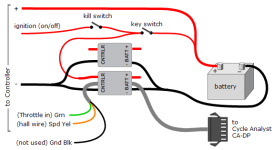mrbill
10 kW
cal3thousand said:
- #2: I've seen that someone else claim (but they didn't show how) to wire up a hack to access the controllers shunt for charging, eliminating the need for an external shunt.
Any help on this is appreciated
I use my controller's shunt for measuring charge going into the battery.
I do this by running out a pair of wires (+ and -) from the controller's power bus on the controller side of its shunt, then splitting it several times (so that I can hook up chargers in parallel or run other accessories off the ebike battery such as headlight, taillight, USB power port, etc.) and have their draw show up on the CA display. When it comes time to charge the battery I don't need to disconnect anything. Only need to connect my charger to one of these connectors so that current flows backward through the controller's shunt and into the battery.
This photo of the backside of an Infineon/LyenMKII EB312 board shows where I connected the leads.
A couple of points:
1. Any power introduced to the controller after its shunt will not show up on the CA display nor be limited by the controller's internal current limit, although this is not much of a concern unless you're load-testing your motor system with a high-current charger or power supply connected.
2. I usually leave the charger connected to the controller overnight and because I want the CA to record the re-charge stats, the controller must remain on for the duration. After the battery is charged, there should be no difference in voltage on either side of the controller's shunt. But, because I zero the CA* to ignore the controller's quiescent current draw and the quiescent draw of a couple of power converters connected after the shunt, the CA continues to see an apparent negative current flowing through the shunt for many hours after the battery is charged. This could amount to 1 to 2 Ah overnight. The longer I leave a charger connected in this manner to 'float' a battery following a charging session, the less accurate the Regen Ah display will be. So, unless I disconnect the charger soon after the battery is charged, the CA will show slightly higher Regen Ah than actually occurred.
I find this recharge-measuring capability most useful when I'm doing a quick recharge before a trip or during a trip, when the recharge may only be partial.
*One could connect a charger in this manner without a battery connected and then zero the CA so that when operating normally (without the charger connected) the CA shows all current drawn from the battery, including quiescent current from controller and any accessory converters.







